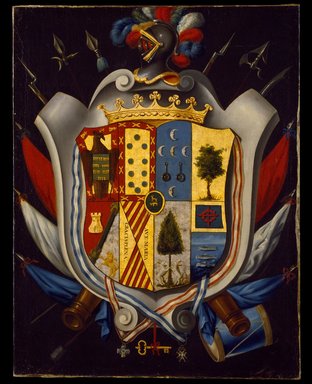Browse

| Accession # | 52.166.18 |
|---|---|
| Artist | Mexican |
| Title | Coat of Arms of the Gómez de Cervantes y Altamirano de Velasco Family |
| Date | ca. 1802 |
| Medium | Oil on canvas |
| Dimensions | 37 1/8 x 28 3/4in. (94.3 x 73cm) frame: 42 x 34 x 1 3/4 in. (106.7 x 86.4 x 4.4 cm) |
| Inscriptions | Inscribed center: "EXANTI/QUIS." Inscribed lower left quadrant: "AVE MARIA/GRACIA PLENA." |
| Credit Line | Museum Collection Fund and Dick S. Ramsay Fund |
| Location | Visible Storage: Case 24, Screen M (Paintings) |
| Description | Cervantes Family Coat of Arms by an unknown artist. This painting was ordered by Don Ygnacio Leonel Gomez de Cervantes to celebrate his marriage with Dona Ana Maria Altamirano Velasco. The coat of arms has the Cervantes quartering in the center which he also ordered. The surrounding quarterings show the union of the two families. Condition: good |
Curatorial Remarks: Even the wealthiest families in colonial Spanish America were compelled to legitimize their place within the imperial system. Elite individuals could obtain titles directly from the crown after proving noble lineage and so-called limpieza de sangre (“purity of blood”), which in Spain excluded people of Jewish and Moorish heritage. Such titles were proudly displayed through coats of arms on portraits, dinner services, coaches, and town-house facades. The commission of this painted, full-scale coat of arms in about 1816—with the central, round Cervantes escutcheon uniting the family's many titles—may have made it unnecessary to include heraldry in contemporary family portraits, which would have hung nearby in the salón del dosel.
Incluso las familias más ricas de la Hispanoamérica colonial se veían obligadas a legitimar su lugar en el sistema imperial. Individuos de élite podían obtener títulos directamente de la corona después de demostrar su linaje noble y la llamada “limpieza de sangre” (pureza de sangre), la cual en España excluía a personas de herencia mora o judía. Tales títulos se exhibían orgullosamente en escudos de armas en retratos, servicios de mesa, carrozas y fachadas de residencias urbanas. El encargo de este escudo de armas, pintado en gran formato alredador de 1816—con el blasón central de Cervantes unificando los muchos títulos de la familia—puede haber hecho innecesario el incluir motivos heráldicos en los retratos familiares contemporáneos, los que debían colgar alrededor de él en el salón del dosel.